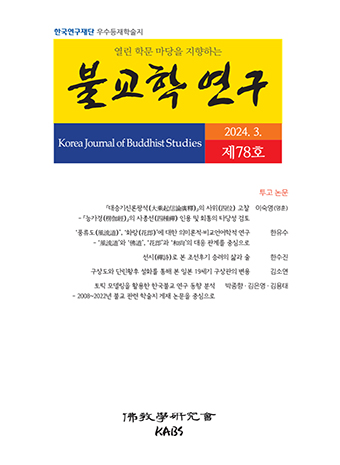Abstract
References
Sorry, not available.
Click the PDF button.
Information
Buddha nature 佛性 can be divided into five kinds. These are as follows: Buddha nature as ① direct cause 正因, as ② behavioral causes 緣因, as ③ epistemic causes 了因, as ④ the result 果 and as ⑤ the result of a result 果果. Generally speaking, Buddha nature as ① the direct cause is the aspect of one’s fundamental mind as thusness that is neither a cause nor a result, ② behavioral causes are altruistic actions towards sentient beings, and ③ epistemic causes are the efforts to develop wisdom. The ④ result therefore is Enlightenment 菩提 and ⑤ the result of result is Parinirvāṇa 大涅槃. But Zhiyi’s 智顗 lectures found in the the Guanyīn Xuanyi 觀音玄義 records, “There is evil in Buddha nature as ② behavioral causes and ③ epistemic causes.” We meet similar teachings not only in Zhiyi’s other works but also in the Vimalakīrti Nirdeśa Sūtra, Abhidharmakośa Bhāṣya and even in the Jātaka. The Guanyin Xuanyi states that “Tathāgata (the Buddha) does not (or cannot) remove evil by nature 性惡.” Most of scholars interpret the meaning of this sentence such that evilness is within the Tathāgata’s own nature. This interpretation is the reason behind the widespread misunderstanding of the evil by nature theory 性惡 found in Tiantai 天台 doctrine. The Buddha nature of the Tathāgata must be the Buddha nature arising from ④ the result 果 (enlightenment) or ⑤ the result of a result 果果 (parinirvāṇa). There cannot be evil within these. In this sentence, ‘evil by nature’ should be translated as ‘the evil in itself’ or ‘the evil in the world.’ According to the Mahāyāna Parinirvāṇa Sūtra, all the sentient beings are Bodhisattvas because they have Buddha nature. So ‘the evil in itself’ or ‘the evil in the world’ is also included in the Buddha nature of ②behavioral causes and ③epistemic causes. The Guanyin Xuanyi also quotes some sentences from the Vimalakīrti Nirdeśa Sūtra. One of the examples is “The Bodhisattva masters 通達 Buddhism by doing evil 非法.” However, the subject of this quotation is changed from the Bodhisattva to the Tathāgata in the quotation. This distortion reveals a theory unique to the Guanyin Xuanyi: the Buddha's doing evil to save sentient beings.
여래성악설은 智顗의 관음현의에서 ‘緣因과 了因에 대해 종합적으로 검토(料簡緣了)’하면서 등장하는데 “연인으로서의 佛性과 요인으로서의 불성에 惡이 있다.”는 이론이 여래성악설이다. 즉 여래성(불성) 가운데 ‘因으로서의 불성’에 악이 있다는 것으로 유마경문소나 법화현의, 마하지관, 삼관의와 같은 지의의 다른 저술은 물론이고 유마경, 심지어 아비달마이론과 본생담에서도 그 맹아를 찾을 수 있다. 지의가 숙독했을 것으로 짐작되는 진제 역 아비달마구사석론에서는 불교수행의 길에서 보살은 煖, 頂, 忍, 世第一法의 四善根 가운데 頂의 단계까지만 소승과 함께 하며 그 이상은 오르면 안 되는데, 왜냐하면 忍의 경지 이후가 되면 三惡道에 떨어지지 못하기 때문이라는 것이다. 또 본생담에서는 석가모니의 전신인 보살이 악을 행하여 악도에 떨어졌지만 보살행을 했다는 일화를 찾을 수 있다. 따라서 여래성악설을 ‘果位인 여래’의 불성에 있는 惡’이 아니라 ‘因位인 보살’의 연인불성과 요인불성에 있는 악이라고 이해할 때 이는 관음현의만의 독특한 사상이 아니다. 또 관음현의에서 “여래가 성악을 끊지 않는다.”고 하지만 이때의 성악은 모든 중생이 보살의 단계에서 짓는 악, 즉 ‘이 세상에 있는 惡 그 자체’이기도 하다. 이는 ‘因位의 보살’로서 짓는 악이기에 연인불성의 악이고 요인불성의 악이기도 하다. 그러나 ‘여래성악’을 ‘여래성의 악’이 아니라 ‘여래에게 있는 性으로서의 악’이라고 이해하게 되면 다른 저술에 실린 智顗의 佛性論은 물론이고 그 당시의 일반적인 佛性 이론과도 어긋난다. ‘果位의 여래’의 불성, 즉 果佛性(菩提)과 果果佛性(大涅槃)에 惡이 있을 수 없기 때문이다. 그런데 관음현의 후반부에서는 “여래가 五逆罪를 짓고 非道(惡)를 행하여 佛道에 통달한다.”고 설명하는데, 이는 유마경의 해당 경문에서 주어로 사용된 보살, 또는 성문을 여래로 대체한 것으로 如來用惡說, 如來行惡說이라고 부를 수 있으며 이 점이야말로 관음현의의 특성이라고 말해야 할 것이다.
Click the PDF button.
- Publisher :Korean Association of Buddhist Studies
- Publisher(Ko) :불교학연구회
- Journal Title :Korea Journal of Buddhist Studies
- Journal Title(Ko) :불교학연구
- Volume : 43
- No :0
- Pages :1 ~ 29


 Korea Journal of Buddhist Studies
Korea Journal of Buddhist Studies






